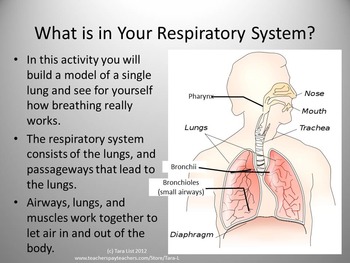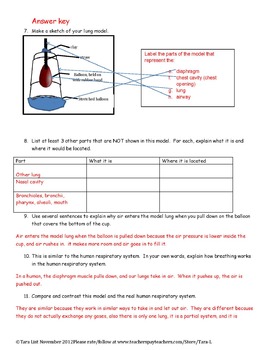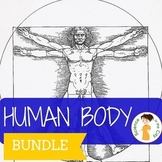Respiratory System Lab Activity
- Zip
What educators are saying
Also included in
- This MONEY SAVING BUNDLE includes all Biology items in my store, now and in the future. All the resources included are shown below, but this bundle includes a full year of warm-up activities, several digital Google Drive activities, a curriculum map/planner, numerous lab activities, a lab rubric, anPrice $118.00Original Price $147.50Save $29.50
- This MONEY-SAVING BUNDLE includes all Human Body items in my store. The Human Body is such a commonly taught subject in so many different grade levels, and these are resources that allow you an EASY way to make them more interactive, hands-on and engaging with very little work on your part. IncludPrice $24.00Original Price $26.90Save $2.90
- This MONEY SAVING BUNDLE includes all PDF (printable) Biology items in my store, now and in the future. All the resources included are shown below, but this bundle includes a full year of warm-up activities, a curriculum map/planner, numerous lab activities, a lab rubric, and several other lessons.TPrice $79.28Original Price $99.10Save $19.82
Description
Students can better understand the respiratory system with a hands-on model. This lab guides students to make a MODEL OF A LUNG, and examine how the lung takes in air. They then draw their model and answer ANALYSIS QUESTIONS about it. INCLUDES: short PowerPoint on the respiratory system (what its functions are, and what the parts of the respiratory system are), READY TO PRINT LAB. Uses readily available inexpensive materials.
Materials:
clear plastic cups, balloons, straws, rubber band, clay.
Contents:
- Cover Page
- Notes Powerpoint
- Guided Notes sheet
- Lab Activity with Question
- Answer Key
I like to use this lab as an introduction to the respiratory system. It
is an engagement activity, and helps clear up a lot of misconceptions about what happens when we breathe. This lab provides great background and a common starting point to build on with more details about the respiratory system. It could also be a good demo, lab at the end of a unit, or even a station if it is already assembled and students use the lung model and answer questions about it.
This was one of my most popular labs with my students last year!
And also available as part of the Human Body Systems Bundle
Common Core Standards Alignment:
CCSS.ELA-Literacy.RST.6-8.3 Follow precisely a multistep procedure when carrying out experiments, taking measurements, or performing technical tasks.
CCSS.ELA-Literacy.RST.6-8.9 Compare and contrast the information gained from experiments, simulations, video, or multimedia sources with that gained from reading a text on the same topic.
**All pictures, graphics, and artwork in our lessons are either purchased legally for use or are created by Science in the City**
Terms of use:
- Purchase of the product is for single classroom use by the purchaser only. It is a violation for individuals, schools, and districts to redistribute, edit, sell, or post this item on the Internet or to other individuals. Disregarding the copyright is a violation of the Digital Millennium Copyright Act and subject to legal action.
-By purchasing this product you acknowledge that you have read and understood the Terms of Use.
You may also be interested in:
Skeletal and Muscular System Lab
Digestive and Excretory System Foldable and Notes
Skeletal and Muscular System Graphic Organizer
Also available as part of Buy my Store Biology
★★★★★★★★★★★★★★★★★★★★★
Don't forget that leaving feedback earns you points toward FREE TPT purchases.
Also, follow me and be notified when new products are uploaded.
Please feel free to contact me with any questions.
★★★★★★★★★★★★★★★★★★★★★
JOIN ME:
Science in the City Blog | Instagram | Pinterest | Facebook








